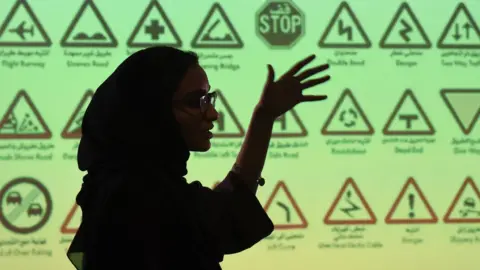Saudi Arabia job growth likely as woman driver ban ends
 Ford
FordSunday marks a historic day for the women of Saudi Arabia.
After more than 60 years spent stuck in the passenger seat, the Gulf kingdom's 15.1 million women can finally take control of the steering wheel when the ban on female drivers is lifted.
Accountancy firm PwC predicts that the number of women on Saudi Arabia's roads will swell to three million by 2020.
Thousands of women have signed up for driving lessons as new female-only programmes have sprung up.
However, those hoping for a quick shot in the arm for the Saudi economy - and its struggling car industry - will have to wait.
New car sales in Saudi Arabia fell 22.3% last year to 536,767 vehicles, according to Matt Gasnier, founder of bestsellingcarsblog.com, which gathers car sales data from manufacturers around the world.
Saudi Arabia fell into recession last year when GDP fell 0.5% due in large part to weaker oil output.
And Mr Gasnier says that the "very difficult" conditions that blighted Saudi Arabia in 2017 have continued into this year.
It may also take some time for enough driving schools that cater solely to women to be set up in Saudi Arabia, though when they are established they will "create a large number of job opportunities for female driving instructors", says PwC.
"It's not all going to happen on day one," says Crystal Worthem, marketing director in the Middle East and Africa for US carmaker Ford, which has set up a driving skills programme for women with Effat University in Jeddah.
Cautious
She thinks that some Saudi women will take a wait-and-see approach to learning to drive, rather than jumping straight in.
It is like downloading new software for a mobile phone, says Ms Worthem: "You don't want to be the first to download it. You want to wait for three months so all the kinks and glitches have been ironed out."
It is not surprising that women from the ultra-conservative Gulf state are cautious.
 Getty Images
Getty ImagesWhile there was no formal ban on female drivers in Saudi Arabia women, have been unable to obtain a driving licence. The policy has been in place since 1957 - though that will change on 24 June.
Last year, Saudi King Salman bin Abdulaziz Al Saud issued a decree stating that the monarchy would start issuing driving licences for women.
His son, Crown Prince Mohammed bin Salman, has set out a plan, called Vision 2030, to diversify the Saudi Arabian economy away from its dependence on oil.
This includes lowering the kingdom's unemployment rate from 11.6% to 7% and increase women's participation in the workforce from 22% to 30%.
Have car, will travel
A report by the Gulf Research Centre said that lifting the driving ban on women "may help them overcome some of the difficulties they face in accessing job opportunities".
The changes have already meant more visibility for Saudi women who work in the car industry.
Abdul Latif Jameel Motors, which is the authorised distributor for Toyota cars in Saudi Arabia, said it had deployed almost 100 female front-line staff in their showrooms to advise women who are looking for a new motor.
Ford has also trained a number of female staff, who previously worked in its back offices, to be able to help women.
But the kingdom has some way to go to hit its Vision 2030 target.
The female labour force participation rate was 20.9% in the final quarter of 2017, according to Saudi Arabia's General Authority for Statistics, compared with a male labour force participation rate of 79%.
In a report, the Gulf Research Centre said it was not immediately clear how much of the low labour participation rate for women was because of the driving ban. However, it said: "Assuming that this is a major handicap, the new law would enable most of the 0.43 million unemployed women to actually contribute to the labour force and the economy."
 Ford
FordIt adds that the new law means many of the 1.5 million Saudi women who are at school or are in training can join the labour force in the years to come.
Winners and losers
Probably the biggest knock-on effects from lifting the ban will be on expatriate drivers - mainly from India and Bangladesh - employed by Saudi households for years to transport women and carry out daily errands.
Out of 1.67 million foreign male domestic workers, 1.38 million of those are drivers in Saudi Arabia, according to the most recent official figures.
Abdullah Ahmed Al-Moghlooth, a member of the Saudi Economic Association, estimates that if the number of expatriate drivers was cut by 50% once the ban is lifted, the country could save as much as 20bn Saudi riyal (£4bn) a year on areas such as salaries and work permit fees.
 Getty Images
Getty ImagesHala Kudwah, Middle East consulting partner and financial services leader at PwC in Saudi Arabia, says it will "alter spending patterns in the kingdom through increased family income and savings in transportation".
While Ms Worthem conceded that the biggest impact of the change would be on drivers, she doesn't expect the workforce to be completely wiped out. "We have seen a decent amount of people saying they would keep a driver on to take children to school," she said.
Though Mr Gasnier doesn't expect women to rush out and buy a car straight away. "There will be women who fire the chauffeur and drive in the car they already own."
Any uplift from new women drivers will be "quite gradual", he says.
